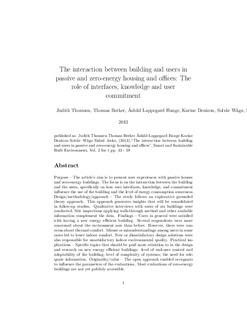| dc.contributor.author | Thomsen, Judith | |
| dc.contributor.author | Berker, Thomas | |
| dc.contributor.author | Hauge, Åshild Lappegard | |
| dc.contributor.author | Denizou, Karine | |
| dc.contributor.author | Wågø, Solvår Irene | |
| dc.contributor.author | Jerkø, Sidsel | |
| dc.date.accessioned | 2017-11-07T10:23:35Z | |
| dc.date.available | 2017-11-07T10:23:35Z | |
| dc.date.created | 2013-04-19T11:04:21Z | |
| dc.date.issued | 2013 | |
| dc.identifier.citation | Smart and Sustainable Built Environment. 2013, 2 (1), 43-59. | nb_NO |
| dc.identifier.issn | 2046-6099 | |
| dc.identifier.uri | http://hdl.handle.net/11250/2464556 | |
| dc.description.abstract | Purpose
– The article's aim is to present user experiences with passive houses and zero‐energy buildings. The focus is on the interaction between the building and the users, specifically on how user interfaces, knowledge, and commitment influence the use of the building and the level of energy consumption awareness.
Design/methodology/approach
– The study follows an explorative grounded theory approach. This approach generates insights that will be consolidated in follow‐up studies. Qualitative interviews with users of six buildings were conducted. Site inspections applying walk‐through method and other available information complement the data.
Findings
– Users in general were satisfied with having a new energy efficient building. Several respondents were more concerned about the environment now than before. However, there were concerns about thermal comfort. Misuse or misunderstandings among users in some cases led to lower indoor comfort. New or dissatisfactory design solutions were also responsible for unsatisfactory indoor environmental quality.Practical implications – Specific topics that should be paid more attention to in the design and research on new energy efficient buildings: level of end‐user control and adaptability of the building; level of complexity of systems; the need for adequate information.
Originality/value
– The open approach enabled occupants to influence the parameters of the evaluations. Most evaluations of zero‐energy buildings are not yet publicly accessible. | nb_NO |
| dc.language.iso | eng | nb_NO |
| dc.publisher | Emerald Group Publishing Limited | nb_NO |
| dc.subject | Energy-efficient buildings | nb_NO |
| dc.subject | Passive Houses | nb_NO |
| dc.subject | Zero‐energy buildings | nb_NO |
| dc.subject | User evaluations | nb_NO |
| dc.subject | Thermal comfort | nb_NO |
| dc.subject | Indoor environment | nb_NO |
| dc.subject | Qualitative method | nb_NO |
| dc.subject | Buildings | nb_NO |
| dc.subject | Energy | nb_NO |
| dc.title | The Interaction between Building and Users in Passive and Zero-Energy Housing and Offices: The Role of Interfaces, Knowledge and User Commitment | nb_NO |
| dc.type | Journal article | nb_NO |
| dc.type | Peer reviewed | nb_NO |
| dc.description.version | acceptedVersion | nb_NO |
| dc.rights.holder | © 2013 Emerald Group Publishing Limited 2013 All rights reserved. This is the authors' accepted and refereed manuscript to the article, post-print. The final publication is available at https://doi.org/10.1108/20466091311325845 | nb_NO |
| dc.subject.nsi | VDP::Samfunnsvitenskap: 200 | nb_NO |
| dc.source.pagenumber | 43-59 | nb_NO |
| dc.source.volume | 2 | nb_NO |
| dc.source.journal | Smart and Sustainable Built Environment | nb_NO |
| dc.source.issue | 1 | nb_NO |
| dc.identifier.doi | 10.1108/20466091311325845 | |
| dc.identifier.cristin | 1024663 | |
| dc.relation.project | Norges forskningsråd: 193830 | nb_NO |
| cristin.unitcode | 7401,30,20,0 | |
| cristin.unitname | Bygninger og installasjoner | |
| cristin.ispublished | true | |
| cristin.fulltext | postprint | |
| cristin.qualitycode | 1 | |
